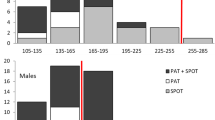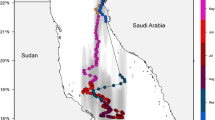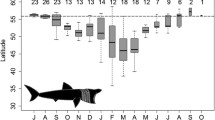Abstract
Partial migration is considered ubiquitous among vertebrates, but little is known about the movements of oceanodromous apex predators such as sharks, particularly at their range extents. PAT-Mk10 and SPOT5 electronic tags were used to investigate tiger shark (Galeocerdo cuvier) spatial dynamics, site fidelity and habitat use off eastern Australia between April 2007 and May 2013. Of the 18 tags deployed, 15 recorded information on depth and/or temperature, and horizontal movements. Tracking times ranged between four and 408 days, with two recovered pop-up archival tags allowing 63 days of high-resolution archived data to be analysed. Overall mean proportions of time-at-depth revealed that G. cuvier spent the majority of time-at-depths of <20 m, but undertook dives as deep as 920 m. Tagged sharks occupied ambient water temperatures from 29.5 °C at the surface to 5.9 °C at depth. Deep dives (>500 m) occurred mostly around dawn and dusk, but no definitive daily dive patterns were observed. Horizontal movements were characterised by combinations of resident and transient behaviour that coincided with seasonal changes in water temperature. While the majority of movement activity was focused around continental slope waters, large-scale migration was evident with one individual moving from offshore Sydney, Australia, to New Caledonia (c. 1,800 km) in 48 days. Periods of tiger shark residency outside of Australia’s fisheries management zones highlight the potential vulnerability of the species to unregulated fisheries and the importance of cross-jurisdictional arrangements for species’ management and conservation.





Similar content being viewed by others
References
Aebischer NJ, Robertson PA, Kenward RE (1993) Compositional analysis of habitat use from animal radio-tracking data. Ecology 74:1313–1325
Baker JD, Antonelis GA, Fowler CW, York AE (1995) Natal site fidelity in northern fur seals, Callorhinus ursinus. Anim Behav 50:237–247
Baum JK, Myers RA, Kehler DG, Worm B, Harley SJ, Doherty PA (2003) Collapse and conservation of shark populations in the northwest Atlantic. Science 299:389–392
Bond ME, Babcock EA, Pikitch EK, Abercrombie DL, Lamb NF, Chapman DD (2012) Reef sharks exhibit site fidelity and higher relative abundance in marine reserves on the Mesoamerican barrier reef. PLoS One 7(3). doi:10.1371/journal.pone.0032983
Brill RW, Holts DB, Chang RKC, Sullivan S, Dewar H, Carey FG (1993) Vertical and horizontal movements of striped marlin (Tetrapturus audax) near the Hawaiian Islands, determined by ultrasonic telemetry, with simultaneous measurement of oceanic currents. Mar Biol 117:567–574
Broderson J, Nicolle A, Nilsson PA, Skov C, Brönmark C, Hansson L (2011) Interplay between temperature, fish partial migration and trophic dynamics. Oikos 120:1838–1846. doi:10.111/j.1600-0706.2011.19433.x
Cagnacci F, Focardi S, Heurich M, Stache A, Hewison AJM, Morellet N, Kjellander P, Linnell JDC, Mysterud A, Neteler M, Delucchi L, Ossi F, Urbano F (2011) Partial migration in roe deer,: migratory and resident tactics are end points of a behavioural gradient determined by ecological factors. Oikos 120:1790–1802. doi:10.1111/j.1600-0706.2011.19441.x
Carey FG, Scharold JV (1990) Movements of blue shark (Prionace glauca) in depth and course. Mar Biol 106:329–342
Chan RWK (2001) Biological studies on sharks caught off the east coast of New South Wales. PhD thesis. University of New South Wales, Australia
Chapman BB, Brönmark C, Nilsson J, Hansson L (2011) The ecology and evolution of partial migration. Oikos 120:1764–1775. doi:10.1111/j.1600-0706.2011.20131.x
Chapman BB, Hulthén K, Broderson J, Nilsson PA, Skov C, Hansson LA, Brönmark C (2012) Partial migration in fishes: causes and consequences. Fish Biol 81:456–478. doi:10.1111/j.1095-8649.2012.03342.x
CLS (2011) Argos Users Manual. http://www.argos-system.org. Accessed 17 Aug 2011
da Silva C, Kerwath SE, Attwood CG, Thorstad EB, Cowley PD, Okland PD, Wilke CG, Naesje TF (2013) Quantifying the degree of protection afforded by no-take marine reserve on an exploited shark. Africa J Mar Sci 35:57–66. doi:10.2989/1814232X.2013.769911
Dingle H (1996) Migration: the biology of life on the move. Oxford University Press, New York
Dingle H, Drake VA (2007) What is Migration? BioOne 57(2):113–121
Dulvy NK, Jennings S, Rogers SI, Maxwell DL (2006) Threat and decline in fishes: an indicator of marine biodiversity. Can J Fish Aquat Sci 63:1267–1275
Dulvy NK, Baum JK, Clarke S, Compagno LJV, Cortés E, Domingo A, Fordham S, Fowler S, Francis MP, Gibson C, Martínez J, Musick JA, Soldo A, Stevens JD, Valenti S (2008) You can swim but you can’t hide: the global status and conservation of oceanic pelagic sharks and rays. Aquat Conserv 18:459–482
Dulvy NK, Fowler SL, Musick JA, Cavanagh RD, Kyne PM, Harrison LR, Carlson JK, Davidson LNK, Fordham SV, Francis MP, Pollock CM, Simpfendorfer CA, Burgess GH, Carpenter KE, Compagno LJV, Ebert DA, Gibson C, Heupel MR, Livingstone SR, Sanciangco JC, Stevens JD, Valenti S, White WT (2013) Extinction risk and conservation of the world’s sharks and rays. eLIFE 3. doi:10.7554/eLife.00590
Everett JD, Baird ME, Oke PR, Suthers IM (2012) An avenue of eddies: quantifying the biophysical properties of mesoscale eddies in the Tasman Sea. Geophys Res Lett 39:LI6608. doi:10.1029/2012GL053091
Field IC, Meekan MG, Buckworth RC, Bradshaw CJA (2009) Protein mining the world’s oceans: Australasia as an example of illegal expansion-and-displacement fishing. Fish Fish 10(3):323–328
Fitzpatrick R, Thums M, Bell I, Meekan MG, Stevens JD, Barnett A (2012) A comparison of the seasonal movements of tiger sharks and green turtles provides insight into their predator-prey relationship. PLoS One 7(12). doi:10.1371/journal.pone.0051927
Forchhammer MC, Post E, Stenseth NC (2002) North Atlantic Oscillation timing of long- and short-distance migration. J Anim Ecol 71:1002–1014
Gillanders BM, Ferrell DJ, Andrew NL (2001) Estimates of movements and life-history parameters of yellow-tail kingfish (Seriola lalandi): how useful are data from a cooperative tagging programme? Mar Fres Res 52:179–192
Green M, Ganassin C, Reid D (2009) Report into the NSW shark meshing (bather protection) program. New South Wales, Australia
Hammerschlag N, Gallagher AJ, Wester J, Luo J, Ault JS (2012) Don’t bite the hand that feeds: assessing ecological impacts of provisioning ecotourism on an apex marine predator. Funct Ecol 26:567–576
Harris PT, Nichol SL, Anderson TJ, Heap AD (2012) Habitats and Benthos of a Deep-Sea Marginal Plateau, Lord Howe Rise, Australia. In: Harris PT, Baker EK (eds) Seafloor geomorphology as benthic habitat. Elsevier, USA. ISBN: 978-0-12-385140-6
Hazin FHV, Afonso AS, De Castilho PC, Ferreira LC, Rocha BCLM (2013) Regional movements of the tiger shark, Galeocerdo cuvier, off northeastern Brazil: inferences regarding shark attack hazard. Ann Braz Acad Sci 85(3):1053–1062
Heithaus MR (2001) The biology of tiger sharks, Galeocerdo cuvier, in Shark Bay, Western Australia: sex ratio, size distribution, diet, and seasonal changes in catch rates. Environ Biol Fish 61(1):25–36
Heithaus MR, Dill LM (2002) Food availability and tiger shark predation risk influence bottlenose dolphin habitat use. Ecology 83(2):480–491
Heithaus MR, Marshall GJ, Buhleier BM, Dill LM (2001) Employing Crittercam to study habitat use and behavior of large sharks. Mar Ecol Prog Ser 209:307–310
Heithaus MR, Dill LM, Marshall GJ, Buhleier B (2002) Habitat use and foraging behavior of tiger sharks (Galeocerdo cuvier) in a seagrass ecosystem. Mar Biol 140(2):237–248
Heithaus MR, Wirsing AJ, Dill LM, Heithaus LI (2007) Long-term movements of tiger sharks satellite-tagged in Shark Bay, Western Australia. Mar Biol 151:1455–1461
Heithaus MR, Frid A, Wirsing AJ, Worm B (2008) Predicting ecological consequences of marine top predator declines. Trends Ecol Evol 23(4):202–210
Holdsworth JC, Sippel TJ, Block BA (2009) Near real time satellite tracking of striped marlin (Kajikia audax) movements in the Pacific Ocean. Mar Biol 156:505–514
Holland KN, Wetherbee BM, Lowe CG, Meyer CG (1999) Movements of tiger sharks (Galeocerdo cuvier) in coastal Hawaiian waters. Mar Biol 134(4):665–673
Holmes BJ, Sumpton WD, Mayer DG, Tibbetts IR, Neil DT, Bennett MB (2012) Declining trends in annual catch rates of the tiger shark (Galeocerdo cuvier) in Queensland, Australia. Fish Res 129–130:38–45
Jaine FRA (2013) The movement ecology of the reef manta ray Manta alfredi in eastern Australia. PhD Thesis, The University of Queensland, Australia
Jorgensen SJ, Reeb CA, Chapple TK, Anderson S, Perle C, Van Sommeran SR, Fritz-Cope C, Brown AC, Klimley AP, Block BA (2010) Philopatry and migration of Pacific white sharks. Proc R Soc B-Biol Sci 277:679–688. doi:10.1098/rspb.2009.1155
Kailola PJ, Williams MJ, Stewart PC, Reichelt RE, McNee A, Grieve C (1993) Australian fisheries resource. FRDC, Canberra
Klimley AP (1993) Highly directional swimming by scalloped hammerhead sharks, Sphyrna lewini, and subsurface irradiance, temperature, bathymetry, and geomagnetic field. Mar Biol 117:1–22
Klimley AP, Beavers SC, Curtis TH, Jorgensen SJ (2002) Movements and swimming behaviour of three species of sharks in La Jolla Canyon, California. Environ Biol Fish 63:117–135
Knip DM, Heupel MR, Simpfendorfer CA (2012) To roam or to home: site fidelity in a tropical coastal shark. Mar Biol 159:1647–1657
Kohler NE, Turner PA (2001) Shark tagging: a review of conventional methods and studies. Environ Biol Fish 60:191–223
Lam VYY, Sadovy de Mitcheson Y (2011) The sharks of South East Asia—unknown, unmonitored and unmanaged. Fish Fish 12:51–74. doi:10.1111/j.1467-2979.2010.00383.x
Lam CH, Nielsen A, Sibert JR (2008) Improving light and temperature based geolocation by unscented Kalman filtering. Fish Res 91:15–25
Last PR, Stevens JD (2009) Sharks and rays of Australia, 2nd edn. CSIRO Publishing, Australia
Litvinov F (2007) Fish visitors to seamounts: aggregations of large pelagic sharks above seamounts. Fish Aqua Res Ser 12:202–206
Lowe CG, Wetherbee BM, Crow GL, Tester AL (1996) Ontogenetic dietary shifts and feeding behavior of the tiger shark, Galeocerdo cuvier, in Hawaiian waters. Environ Biol Fish 47(2):203–211
Lowe CG, Wetherbee BM, Meyer CG (2006) Using acoustic telemetry monitoring techniques to quantify movement patterns and site fidelity of sharks and giant trevally around French Frigate Shoals and Midway Atoll. Atoll Res Bull 543:281–303
Lowry M, Murphy J (2003) Monitoring the recreational gamefish fishery off southeastern Australia. Mar Fresh Res 54:425–434
Lynch PD, Shertzer KW, Latour RJ (2012) Performance of methods used to estimate indices of abundance for highly migratory species. Fish Res 125–126:27–39. doi:10.1016/j.fishres.2012.02.005
Macbeth WG, Geraghty PT, Peddemors VM, Gray CA (2009) Observer-based study of targeted commercial fishing for large shark species in waters off northern New South Wales. Industry and Investment New South Wales, Cronulla
Maunder MN, Punt AE (2004) Standardizing catch and effort: a review of recent approaches. Fish Res 70:141–159. doi:10.1016/j.fishres.2004.08.002
Meyer CG, Clark TB, Papastamatiou YP, Whitney NM, Holland KN (2009) Long-term movement patterns of tiger sharks Galeocerdo cuvier in Hawaii. Mar Ecol Prog Ser 381:223–235
Meyer CG, Papastamatiou YP, Holland KN (2010) A multiple instrument approach to quantifying the movement patterns and habitat use of tiger (Galeocerdo cuvier) and Galapagos sharks (Carcharhinus galapagensis) at French Frigate Shoals, Hawaii. Mar Biol 157:1857–1868
Meyer CG, O’Malley JM, Papastamatiou YP, Dale JJ, Hutchinson MR, Anderson JM, Royer MA, Holland KN (2014) Growth and maximum size of tiger sharks (Galeocerdo cuvier) in Hawaii. PLoS One 9(1):e84799. doi:10.1371/journalpone.0084799
Myers RA, Baum JK, Shepherd TD, Powers SP, Peterson CH (2007) Cascading effects of the loss of apex predatory sharks from a coastal ocean. Science 315:1846–1850
Mysterud A, Loe LE, Zimmermann B, Bischof R, Veiberg V, Meisingset E (2011) Partial migration in expanding red deer populations in northern latitudes—a role for density dependence? Oikos 120:1817–1825. doi:10.1111/j.1600-0706.2010.19439.x
Nakamura I, Wantanabe YY, Papastamatiou YP, Katsufumi S, Meyer CG (2011) Yo-yo vertical movements suggest a foraging strategy for tiger sharks Galeocerdo cuvier. Mar Ecol Prog Ser 424:237–246
Nathan R, Getz WM, Revilla E, Holyoak M, Kadmon R, Saltz D, Smouse PE (2008) A movement ecology paradigm for unifying organismal movement research. Proc Nat Acad 105:19052–19059. doi:10.1073/pnas.0800375105
Nielsen A, Bigelow KA, Musyl MK, Sibert JR (2006) Improving light-based geolocation by including sea surface temperature. Fish Ocean 15(4):314–325. doi:10.1111/j.1365-2419.2005.00401.x
Papastamatiou YP, Wetherbee BM, Lowe CG, Crow GL (2006) Distribution and diet of four species of carcharhinid shark in the Hawaiian Islands: evidence for resource partitioning and competitive exclusion. Mar Ecol Prog Ser 320:239–251
Papastamatiou YP, Cartamil DP, Lowe CG, Meyer CG, Wetherbee BM, Holland KN (2011) Scales of orientation, directed walks and movement path structure in sharks. J Anim Ecol 80:864–874. doi:10.1111/j.1365-2656.2011.01815.x
Papastamatiou YP, Meyer CG, Carvalho F, Dale JJ, Hutchinson MR, Holland KN (2013) Telemetry and random walk models reveal complex patterns of partial migration in a large marine predator. Ecol Soc Am 94:2595–2606. doi:10.1890/12-2014.1
Park T (2007) NSW gamefish tournament monitoring. Angling research tournament monitoring program. NSW Department of Primary Industries, Cronulla
Paterson RA (1990) Effects of long-term anti-shark measures on target and non-target species in Queensland, Australia. Biol Conserv 52:147–159
Pepperell JG (2008) Monitoring and research on landed fish at game fishing tournaments in NSW. Pepperell Research and Consulting Pty Ltd, Australia
Pratt HL, Carrier JC (2001) A review of elasmobranch reproductive behaviour with a case study on the nurse shark, Ginglymostoma cirratum. Environ Biol Fish 60(1–3):157–188
R Core Team (2012) R: A language and environment for statistical computing. R Foundation for Statistical Computing, Vienna, Austria. ISBN: 3-900051-07-0, URL http://www.R-project.org/
Reid DD, Krough M (1992) Assessment of catches from protective shark meshing off New South Wales beaches between 1950 and 1990. Aust J Mar Fres Res 43:283–296. doi:10.1071/MF9920283
Reid DD, Robbins WD, Peddemors VM (2011) Decadal trends in shark catches and effort from the New South Wales Shark Meshing Program 1950 to 2010. Mar Fresh Res 62:676–693
Ridgway KR, Godfrey JS (1997) Seasonal cycle of the East Australian Current. J Geophys Res 102(10):921–936
Rowling K, Hegarty A, Ives M (2010) Status of fisheries resources in NSW 2008/09. NSW Industry and Investment, Cronulla
Simpfendorfer C (1992) Biology of tiger sharks (Galeocerdo cuvier) caught in the Queensland shark meshing program off Townsville, Australia. Aust J Mar Fres Res 43:33–43. doi:10.1071/MF9920033
Simpfendorfer C (2009) Galeocerdo cuvier. The IUCN Red List of Threatened Species. Version 2014.2. www.iucnredlist.org
Sippel T, Holdsworth J, Dennis T, Montgomery J (2011) Investigating behaviour and population dynamics of striped marlin (Kajikia audax) from the southwest Pacific Ocean with satellite tags. PLoS One 6(6). doi:10.1371/journal.pone.0021087
Skov C, Aarestrup K, Baktoft H, Brodersen J, Brönmark C, Hansson L, Nielsen EE, Nielsen T, Nilsson PA (2010) Influences of environmental cues, migration history, and habitat familiarity on partial migration. Behav Ecol 21:1140–1146. doi:10.1093/beheco/arq121
Steinberg C (2007) Impacts of climate change on the physical oceanography of the Great Barrier Reef. In: Johnson JE, Marshall PA (eds) Climate change and the great barrier reef. Great Barrier Reef Marine Park Authority and Australian Greenhouse Office, Australia
Stevens JD (1984) Biological observations on sharks caught by sport fishermen off New South Wales. Aust J Mar Fres Res 35:573–590
Stevens JD, West GJ, McLoughlin KJ (2000) Movements, recapture patterns, and factors affecting the return rate of carcharhinid and other sharks tagged off northern Australia. Mar Fresh Res 51:127–141
Tavares R, Ortiz M, Arocha F (2012) Population structure, distribution and relative abundance of the blue shark (Prionace glauca) in the Caribbean Sea and adjacent waters of the North Atlantic. Fish Res 129–130:137–152. doi:10.1016/j.fishres.2012.06.018
Vaudo JJ, Wetherbee BM, Harbey G, Nemeth RS, Aming C, Burnie N, Howey-Jordan LA, Shivji MS (2014) Intraspecific variation in vertical habitat use by tiger sharks (Galeocerdo cuvier) in the western North Atlantic. Ecol Evol 4(10):1768–1786
Weng KC, Boustany AM, Pyle P, Anderson SD, Brown A, Block BA (2007) Migration and habitat of white sharks (Carcharhodon carcharias) in the eastern Pacific Ocean. Mar Biol 152(4):877–894. doi:10.1007/s00227-007-0739-4
Werry JM, Planes S, Berumen ML, Lee KA, Braun CD, Clua E (2014) Reef-fidelity and migration of tiger sharks, Galeocerdo cuvier, across the Coral Sea. PLoS One 9(1):e83249. doi:10.1371/journal.pone.0083249
Williams LE (2002) Queensland’s fisheries resources: current conditions and recent trends 1988–2000. Department of Primary Industries, Queensland
Wirsing AJ, Heithaus MR, Dill LM (2006) Tiger shark (Galeocerdo cuvier) abundance and growth in a subtropical embayment: evidence from 7 years of standardized fishing effort. Mar Biol 149:961–968
Zischke MT, Griffiths SP, Tibbetts IR (2012) Catch and effort from a specialised recreational pelagic sport fishery off eastern Australia. Fish Res 127–128:61–72
Acknowledgments
We wish to acknowledge the contribution of those who donated their time, effort and funds in support of the tagging operations in this study, especially Greg Barea, Paddy Dimond, Mark Doohan, Tony Ham, Wayne Sumpton, Jeff Krause, Matt Ghosn, David Toohey, Jamie Ward, Anthony Sawa, Mark Cawthray, Michael Swindells, and Drs. Adrian Gutteridge, Lindsay Marshall and Jonathan Werry. We also give our deepest gratitude to the numerous volunteers that helped with fieldwork, especially Aaron Davison and Simon Harmon. Thanks also to Tim Lam, Tu Nguyen, Robert Campbell and Nadia Engstrom for help with tag analysis, mapping and commercial fishing information. We would like to acknowledge the research sponsors Fellowship Fund Incorporated, F.G. Wilson Pty. Ltd., RipCom Telecommunications, Elanora State School, Mohammed Bin Zayed Species Conservation Fund, Discovery Channel, Wildlife Preservation Society of Queensland, Fisheries Queensland, New South Wales Recreational Fishing Trust and the New South Wales Game Fishing Association. In-kind support was gratefully received from the Moreton Bay Research Station, Tangalooma Wild Dolphin Resort and the Fox Research Station.
Author information
Authors and Affiliations
Corresponding author
Additional information
Communicated by D. Righton.
Rights and permissions
About this article
Cite this article
Holmes, B.J., Pepperell, J.G., Griffiths, S.P. et al. Tiger shark (Galeocerdo cuvier) movement patterns and habitat use determined by satellite tagging in eastern Australian waters. Mar Biol 161, 2645–2658 (2014). https://doi.org/10.1007/s00227-014-2536-1
Received:
Accepted:
Published:
Issue Date:
DOI: https://doi.org/10.1007/s00227-014-2536-1




